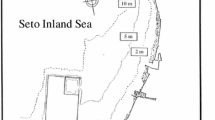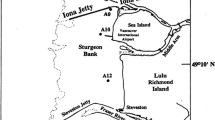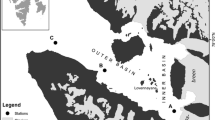Abstract
Five field surveys were conducted in an estuarine intertidal sandflat of the Seto Inland Sea (Japan) between April 1994 and April 1995. Chlorophyll a, pheopigments, total organic carbon and acid-volatile sulphides (AVS) of surface and subsurface sediments, and macrofaunal assemblages were investigated in parallel at 15 stations. Monthly hydrological data of low-tide creek water adjacent to the flat were used as a complementary environmental characterisation of the study area. Strong temporal changes were found among sampling dates, most remarkably in autumn with a major increase of algal detritus and AVS, a sharp reduction in macrofaunal abundances and species richness, and a massive mortality of the clam Ruditapes philippinarum. This dystrophic event was preceded by a photoautotrophic and hypertrophic spring–summer characterized by abundant fresh (i.e., living) algal material, including microphytobenthos and macroalgae (Ulva sp.). In summer, abundant macrofaunal assemblages reached the highest biomass values (455 g wet weight m−2 or 60.6 g ash free dry weight m−2), with a major contribution of filter-feeding bivalves Musculista senhousia and R. philippinarum. These are among the highest values reported in the literature for sedimentary shores. From autumn, there was a progressive recolonisation of macrofauna, initiated by few opportunistic polychaetes (e.g., Cirriformia tentaculata and Polydora sp.), apparently promoting a fast sediment recovery in winter, and followed by new bivalve recruits in the next spring. This study provides the first evidence of significant and interlinked within-year changes in chemical characteristics of sediments and macrofaunal assemblages in an estuarine intertidal flat at a small spatial scale (i.e., tens of meters). This demonstrates the high temporal variability of species–environment relations in these systems and a close relationship in seasonally driven trophodynamic processes among primary producers and benthic consumers. We conclude that a thorough parallel evaluation of the temporal changes in chemical characteristics of sediments should be taken into account in assessing the year-round distribution and changes of intertidal macrofauna, particularly in eutrophic, estuarine intertidal flats.





Similar content being viewed by others
References
Abele-Oescher D, Theede H (1991) Digestion of algal pigments by the common periwinkle Littorina littorea L. (Gastropoda) J Exp Mar Biol Ecol 147:177–184
Allen PL, Moore JJ (1987) Invertebrate macrofauna as potential indicators of sandy beach instability. Estuar Coast Shelf Sci 24:109–125
Ahn IY, Choi JW (1998) Macrobenthic communities impacted by anthropogenic activities in an intertidal sand flat on the west coast (Yellow sea) of Korea. Mar Poll Bull 36:808–817
Anderson MJ (2001) A new method for non-parametric multivariate analysis of variance. Aust J Ecol 26:32–46
Arias AM, Drake P (1994) Structure and production of the benthic macroinvertebrate community in a shallow lagoon in the Bay of Cádiz. Mar Ecol Prog Ser 115:151–167
Balducci C, Sfriso A, Pavoni B (2001) Macrofauna impact on Ulva rigida C. Ag. Production and relationship with environmental variables in the lagoon of Venice. Mar Environ Res 52:27–49
Bartoli M, Nizzoli D, Welsh DT, Viaroli P (2000) Short-term influence of recolonisation by the polychaete worm Nereis succinea on oxygen and nitrogen fluxes and denitrification: a microcosm simulation. Hydrobiologia 431:165–174
Bartoli M, Nizzoli D, Viaroli P, Turolla E, Castaldelli G, Fano EA, Rossi R (2001) Impact of Tapes philippinarum on nutrient dynamics and benthic respiration in the Sacca di Goro. Hydrobiologia 455:203–212
Bartoli M, Naldi M, Nizzoli D, Roubaix V, Viaroli P (2003) Influence of clam farming on macroalgal growth: a microcosm experiment. Chem Ecol 19:147–160
Bartoli M, Nizzoli D, Naldi M, Vezzulli L, Porrello S, Lenzi M, Viaroli P (2005) Inorganic nitrogen control in wastewater treatment ponds from a fish farm (Orbetello, Italy): denitrification versus Ulva uptake. Mar Poll Bull 50(11):1386–1397
Bianchi TS (1988) Feeding ecology of subsurface deposit-feeder Leitoscoloplos fragilis Verrill. I. Mechanisms affecting particle availability on intertidal sandflat. J Exp Mar Biol Ecol 115:79–97
Bianchi TS, Dawson R, Sawangwong P (1988) The effects of macrobenthic deeposit-feeding on the degradation of chloropigments in sandy sediments. J Exp Mar Biol Ecol 122:243–255
Bourget E, Messier D (1983) Macrobenthic density, biomass, and fauna of intertidal and subtidal sand in a Magdalen Islands lagoon, Gulf of St. Lawrence. Can J Zool 61:2509–2518
Brazeiro A, Defeo O (1996) Macrofauna zonation in microtidal sandy beaches: it is possible identify pattern in such variable environments? Estuar Coast Shelf Sci 42:523–526
Brown AC, McLachlan A (1990) Ecology of sandy shores. Elsevier, Amsterdam
Castel J, Labourg PJ, Escaravage V, Auby I, Garcia ME (1989) Influence of seagrass beds and oyster parks on the abundance and biomass patterns of meio- and macrobenthos in tidal flats. Estuar Coast Shelf Sci 28:71–85
Clarke KR (1993) Non-parametric multivariate analyses of changes in community structure. Aust J Ecol 18:117–143
Clarke KR, Warwick RM (2001) Changes in marine communities: an approach to statistical analysis and interpretation, 2nd edn. PRIMER-E Ltd, Plymouth
Cognetti G (1982) Adaptive strategies of brackish water fauna in pure and polluted water. Mar Pollut Bull 13:247–250
Commito JA, Celano EA, Celico HJ, Como S, Johnson CP (2005) Mussels matter: postlarval dispersal dynamics altered by a spatially complex ecosystem engineer. J Exp Mar Biol Ecol 316:133–147
Crooks JA (1996) The population ecology of an exotic mussel, Musculista senhousia, in a southern California bay. Estuaries 19:42–50
Crooks JA (1998) Habitat alteration and community-level effects of an exotic mussel, Musculista senhousia. Mar Ecol Prog Ser 162:137–152
Crooks JA (2001) Assessing invader roles within changing ecosystems: historical and experimental perspectives on an exotic mussel in an urbanized lagoon. Biol Invasions 3:23–36
D’Avanzo C, Alber M, Valiela I (1991) Nitrogen assimilation from amorphus detritus by two coastal consumers. Estuar Coast Shelf Sci 33:203–209
Defeo O, McLachlan A (2005) Patterns, processes and regulatory mechanisms in sandy beach macrofauna: a multi-scale analysis. Mar Ecol Prog Ser 295: 1–20
Dexter DM (1984) Temporal and spatial variability in the community structure of the fauna of four sandy beaches in South-eastern New South Wales. Aust J Mar Freshw Res 35:663–672
Dyer KR, Christie MC, Feates N, Fennessy MJ, Pejrup M, van der Lee W (2000) An investigation into processes influencing the morphodynamics of an intertidal mudflat, the Dollard estuary, the Netherlands: I. Hydrodynamics and suspended sediments. Estuar Coast Shelf Sci 50:607–625
Everett RA (1994) Macroalgae in marine soft-sediment communities: effects on benthic faunal assemblages. J Exp Mar Biol Ecol 175:253–274
Fueller CM (1994) Effects of porewater hydrogen sulfide on the feeding activity of the subsurface deposit-feeding polychaete, Clymenella torquata, Leidy. J Mar Res 52:1101–1127
Gillmor RB (1982) Assessment of intertidal growth and capacity adaptations in suspension-feeding bivalves. Mar Biol 68:277–286
Grant J (1981) Sediment transport and disturbance on an intertidal sandflat: infaunal distribution and recolonization. Mar Ecol Prog Ser 6:249–255
Haynes D, Quinn GP (1995) Temporal and spatial variability in community structure of a sandy intertidal beach, Cape Paterson, Victoria, Australia. Mar Freshw Res 46:931–942
Hawkins AJS, Smith RFM, Bayne BL, Héral M (1996) Novel observations underlying the fast growth of suspension-feeding shellfish in turbid environments: Mytilus edulis. Mar Ecol Prog Ser 131:179–190
Heip CHR, Goosen NH, Herman PMJ, Kromkamp J, Middelburg JJ, Soetart K (1995) Production and consumption of biological particles in temperate tidal estuaries. Oceanogr Mar Biol Ann Rev 33:1–149
Hewitt JE, Pridmore RD, Thrush SF, Cummings VJ (1997) Assessing the short-term stability of spatial patterns of macrobenthos in a dynamic estuarine system. Limnol Oceanogr 42:282–288
James RJ, Fairweather PG (1996) Spatial variation of intertidal macrofauna on a sandy ocean beach in Australia. Estuar Coast Shelf Sci 43:81–107
Jaramillo E, McLachlan A, Coetzee P (1993) Intertidal zonation patterns of macroinfauna over a range of exposed sandy beaches in south-central Chile. Mar Ecol Prog Ser 101:105–118
Jones AR, Watson-Russell CJ, Murray A (1986) Spatial patterns in the macrobenthic communities of the Hawkesbury estuary, New South Wales. Aust J Mar Freshw Res 37:521–543
Kanaya G, Nobata E, Toya T, Kikuchi E (2005) Effects of different feeding habits of three bivalve species on sediment characteristics and benthic diatom abundance. Mar Ecol Prog Ser 299:67–78
Kasai A, Horie H, Sakamoto W (2004) Selection of food sources by Ruditapes philippinarum and Mactra veneriformis (Bivalva: Mollusca) determined from stable isotope analysis. Fish Sci 70:11–20
Karrh RR, Miller DC (1996) Effect of flow and sediment transport on feeding rate of the surface-deposit feeder Saccoglossus kowalevskii. Mar Ecol Prog Ser 130:125–143
Krager CD, Woodin SA (1993) Spatial persistence and sediment disturbance of an arenicolid polychaete. Limnol Oceanogr 38:509–520
Lansó RJ (1991) Tolerance of low dissolved oxygen and hydrogen sulfide by the polychaete Streblospio benedecti (Webster). J Exp Mar Biol Ecol:153:165–178
Lopez GR, Levington JS (1987) Ecology of deposit-feeding animals in marine sediments. Quart Rev Biol 62:235–260
Lorenzen CJ (1967) Determination of chlorophyll and pheo-pigments: spectrophotometric equations. Limnol Oceanogr 12:343–346
Magni P (1998) A multidisciplinary study on the dynamics of biophilic elements (C, N, P, Si) in a tidal estuary of the Seto Inland Sea, Japan: physico-chemical variability and macrozoobenthic communities. PhD Thesis, The United Graduate School of Ehime University, Ehime
Magni P, Montani S (1997) Development of benthic microalgal assemblages on an intertidal flat in the Seto Inland Sea, Japan: effects of environmental variability. La Mer 35:137–148
Magni P, Montani S (1998) Responses of intertidal and subtidal communities of the macrobenthos to organic load and oxygen depletion in the Seto Inland, Japan. J Rech Océanogr 23:47–56
Magni P, Montani S (2000) Physical and chemical variability in the lower intertidal zone of an estuary in the Seto Inland Sea, Japan: seasonal patterns of dissolved and particulate compounds. Hydrobiologia 432:9–23
Magni P, Montani S (2005) Physical and chemical variability of tidal streams. In: Lehr JH, Keeley J, Lehr J, Kingery TB III (eds) Water encyclopedia, vol 4. Wiley, Hoboken, pp 6–11
Magni P, Abe N, Montani S (2000a) Quantification of microphytobenthos biomass in intertidal sediments: layer-dependent variation of chlorophyll a content determined by spectrophotometric and HPLC methods. La Mer 38:57–63
Magni P, Montani S, Takada C, Tsutsumi H (2000b) Temporal scaling and relevance of bivalve nutrient excretion on a tidal flat of the Seto Inland Sea, Japan. Mar Ecol Prog Ser 198:139–155
Magni P, Montani S, Tada K (2002) Semidiurnal dynamics of salinity, nutrients and suspended particulate matter in an estuary in the Seto Inland Sea, Japan, during a spring tide cycle. J Oceanogr 58:389–402
Magni P, Micheletti S, Casu D, Floris A, Giordani G, Petrov A, De Falco G, Castelli A (2005) Relationships between chemical characteristics of sediments and macrofaunal communities in the Cabras lagoon (Western Mediterranean, Italy). Hydrobiologia 550:105–119
Mann KH (1986) The role of detritus at the land-sea boundary. In: Lasserre P, Martin JM (eds) Biogeochemical processes at the land-sea boundary. Elsevier, Amsterdam, pp 123–139
McArdle BH, Blackwell RG (1989) Measurement of density variability in the bivalve Chione stutchburyi using spatial correlation. Mar Ecol Prog Ser 52:245–252
McArdle BH, Anderson MJ (2001) Fitting multivariate models to community data: a comment on distance-based redundancy analysis. Ecology 82:290–297
McLachlan A (1996) Physical factors in benthic ecology: effects of changing sand particle size on beach fauna. Mar Ecol Prog Ser 131:205–217
Meksumpun C, Merksumpun S (1999) Polychaete–sediment relations in Rayong, Thailand. Environ Poll 105:447–456
Middelburg JJ, Barranguet C, Boschker HTS, Herman PMJ, Moens T, Heip CHR (2000) The fate of intertidal microphytobenthos carbon: an in situ 13C-labeling study. Limnol Oceanogr 45:1224–1234
Miller DC, Bock MJ, Turner EJ (1992) Deposit and suspension feeding in oscillatory flows and sediment fluxes. J Mar Res 50:489–520
Mistri M (2004) Effect of Musculista senhousia mats on clam mortality and growth: much ado about nothing? Aquaculture 241:207–218
Montani S, Magni P, Shimamoto M, Abe N, Okutani K (1998) The effect of a tidal cycle on the dynamics of nutrients in a tidal estuary in the Seto Inland Sea, Japan. J Oceanogr 54:65–76
Montani S, Magni P, Abe N (2003) Seasonal and interannual patterns of intertidal microphytobenthos in combination with laboratory and areal production estimates. Mar Ecol Prog Ser 249:79–91
Morrisey DJ, Howitt L, Underwood AJ, Stark JS (1992) Spatial variation in soft-sediment benthos. Mar Ecol Prog Ser 81:197–204
Nicotri ME (1977) Grazing effects of four marine intertidal herbivores on the microflora. Ecology 58:1020–1032
Norkko A, Bonsdorff E (1996a) Altered benthic prey-availability due to episodic oxygen deficiency caused by drifting algal mats. PSZN I: Mar Ecol 17:355–372
Norkko A, Bonsdorff E (1996b) Rapid zoobenthic community responses to accumulations of drifting algae. Mar Ecol Prog Ser 131:143–157
Oeschger R, Vismann B (1994) Sulphide tolerance in Heteromastus filiformis (Polychaeta): mitochondrial adaptations. Ophelia 40:147–158
Ólafsson EB (1988) Inhibition of larval settlement to a soft bottom benthic community by drifting algal mats: an experimental test. Mar Biol 97:571–574
Parsons TR, Maita M, Lalli CM (1984) A manual of chemical and biological methods for seawater analysis. Pergamon, Oxford
Reise K (1979) Spatial configurations generated by motile benthic polychaetes. Helg Meer 32:55–72
Renshun Z (1992) Suspended sediment transport processes on tidal mud flat in Jiangsu Province, China. Estuar Coast Shelf Sci 35:225–233
Ricciardi A, Bourget E (1998) Weight to weight conversion factors for marine benthic macroinvertebrates. Mar Ecol Prog Ser 163:245–251
Ricciardi A, Bourget E (1999) Global patterns of macroinvertebrate biomass in marine intertidal communities. Mar Ecol Prog Ser 185:21–35
Richardson CA, Ibarrola I, Ingham RJ (1993) Emergence pattern and spatial distribution of the common cockle Cerastoderma edule. Mar Ecol Prog Ser 99:71–81
Saiz-Salinas JI, Francés-Zubillaga G (1997) Enhanced growth in juvenile Nereis diversicolor after its exposure to anaerobic polluted sediments. Mar Poll Bull 34:437–442
Sfriso A, Birkemeyer T, Ghetti PF (2001) Benthic macrofauna changes in areas of Venice lagoon populated by seagrasses or seaweeds. Mar Environ Res 52:323–349
Smith D, Hughes RG, Cox EJ (1996) Predation of epipelic diatoms by the amphipod Corophium volutator and the polychete Nereis diversicolor. Mar Ecol Prog Ser 145:53–61
Sokal RR, Rohlf FJ (1995) Biometry. Freeman & Company, New York
Tagliapietra D, Pavan M, Wagner C (1998) Macrobenthic community changes related to eutrophication in Palude della Rosa (Venetian lagoon, Italy). Estuar Coast Shelf Sci 47:217–226
Takai N, Mishima Y, Yorozu A, Hoshika A (2002) Carbon sources for demersal fish in the western Seto Inland Sea, Japan, examined by δ13C and δ15N analyses. Limnol Oceanogr 47:730–741
Takai N, Yorozu A, Tanimoto T, Hoshika A, Yoshihara K (2004) Transport pathways of microphytobenthos-originating organic carbon in the food web of an exposed hard bottom shore in the Seto Inland Sea, Japan. Mar Ecol Prog Ser 284:97–108
Tamaki A (1987) Comparison of resistivity to transport by wave action in several polychaete species on an intertidal sand flat. Mar Ecol Prog Ser 37:181–189
Tanaka M, Kikuchi T (1978) Ecological studies on benthic macrofauna in Tomoe Cove, Amakusa. II. Production of Musculista senhousia (Bivalvia, Mytilidae). Publ Amakusa Mar Biol Lab Kyushu Univ 4:215–233
Thrush SF (1991) Spatial patterns in soft-bottom communities. Tree 6:75–70
Thrush SF, Hewitt JE, Pridmore RD (1989) Patterns in the spatial arrangements of polychaetes and bivalves in intertidal sandflats. Mar Biol 102:529–535
Tsutsumi H (1987) Population dynamics of Capitella capitata (Polychaeta; Capitellidae) in an organically polluted cove. Mar Ecol Prog Ser 36:139–149
Tsutsumi H, Kikuchi T (1983) Benthic ecology of a small cove with seasonal oxygen depletion caused by organic pollution. Publ Amakusa Mar Biol Lab Kyushu Univ 7:17–40
Uchida M, Numagughi K (1996) Formation of protoplasmatic detritus with characteristics as food for secondary animals during microbial decomposition of Ulva pertusa (Chlorophyta) frond. J Mar Biotechnol 4:200–206
Underwood AJ (1997) Experiments in ecology: their logical design and interpretation using analysis of variance. Cambridge University Press, Cambridge
Viaroli P, Christian RR (2003) Description of trophic status, hyperautotrophy and dystrophy of a coastal lagoon through a potential oxygen production and consumption index-TOSI: trophic Oxygen Status Index. Ecol Indic 3:237–250
Winer BJ, Brown DR, Michels KM (1991) Statistical principles in experimental design. 3rd edn. McGraw Hill, New York
Whitlatch RB (1981) Animal-sediment relationship in intertidal marine benthic habitats: some determinants of deposit-feeding species diversity. J Exp Mar Biol Ecol 53:31–45
Yin K, Harrison PJ, Pond S, Beamish RJ (1995) Entrainment of nitrate in the Fraser river estuary and its biological implications. II. Effects of spring vs. neap tide and river discharge. Estuar Coast Shelf Sci 40:529–544
Ysebaert T, Herman PMJ (2002) Spatial and temporal variation in benthic macrofauna and relationships with environmental variables in an estuarine, intertidal soft-sediment environment. Mar Ecol Prog Ser 244:105–124
Yokoyama H (1998) Three polychaetes indicating different stages of organic pollution. J Rech Océanogr 23:67–74
Yokoyama H (2002) Impact of fish and pearl farming on the benthic environment in Gokasho bay: evaluation from seasonal fluctuations of the macrobenthos. Fish Sci 68:258–268
Acknowledgements
We wish to thank K. Ichimi and the students of the Laboratory of Environmental Oceanography, Kagawa University, particularly T. Sezaki and M. Harada, for their cooperation during the field work and assistance in the laboratory. This study was partly supported by a research fund (15201001) from the Ministry of Education, Culture, Sports, Science and Technology of Japan (Grant-in-Aid of Scientific Research). It is contribution number MPS-06013 of the EU Network of Excellence MarBEF.
Author information
Authors and Affiliations
Corresponding author
Additional information
Communicated by R. Cattaneo-Vietti, Genova
Rights and permissions
About this article
Cite this article
Magni, P., Como, S., Montani, S. et al. Interlinked temporal changes in environmental conditions, chemical characteristics of sediments and macrofaunal assemblages in an estuarine intertidal sandflat (Seto Inland Sea, Japan). Mar Biol 149, 1185–1197 (2006). https://doi.org/10.1007/s00227-006-0298-0
Received:
Accepted:
Published:
Issue Date:
DOI: https://doi.org/10.1007/s00227-006-0298-0




